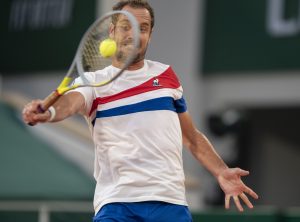This year’s Australian Open featured a sterling gold star, and it’s not Naomi Osaka, Novak Djokovic or Daniil Medvedev. It’s a certain type of serve that stood out as sneaky-effective.
The hubbub over Covid-19 and quarantines made a change in Melbourne fly slightly under the radar. In 2020, a new court surface was installed by the company Greenset. For 2021, it appears that new surface was tweaked with less sand. The result: conditions were speed-of-light fast. In fact, comparing the surface to “ice,” Djokovic estimates these to have been the quickest courts he’s seen down under to date.
Fast courts typically favor big servers because returners have less time to catch up to the ball. If that’s true, why wouldn’t ATP serve kings like Milos Raonic and Nick Kyrgios have had more success this year? It is Djokovic, not a speed-monger, who has bashed 100 aces on the way to the final– tops in the tournament. The answer is, it’s not just power. Some of the best spot servers in the game found the weapon that crushed the competition at the Australian Open in 2021.
That serve: Slider out wide.
Shane Liyanage of Data Driven Sports Analytics, which provides strategy to players on both the ATP and WTA tours picked up on this nuance early in the tournament. “The out-wide serves, in particular the sliders out wide, are more effective this year because of the court speed,” he said.
What is a slider? It’s something a little more vicious than a typical slice serve. It has more cut, harsher spin and more directional change after the bounce. Pair that with an out-wide location for a right-handed server in the deuce court or a left-handed server in the ad court, and the result is a tailing nightmare to return.
A look at the data from this Australian Open’s two men’s finalists reveals the success of the slider out wide. But first a few notes. Both Djokovic and Medvedev are right-handed, as are all of the players from the six matches they played leading into the final.
That means the slider out wide would be used when serving in the deuce court, in order to get that wicked spin that trails off the court. But normally, there’s a big risk in serving out-wide in the deuce court to a right-hander– you’re giving him the ball to his forehand.
Most players favor their forehand and can rip into returns, creating speed, depth, angle or whatever they want.
That makes the propensity to serve out wide in the deuce court to righties so fascinating.
Both Djokovic and Medvedev have taken that risk, and it has paid off. Now to the location numbers. According to Australian Open data provider Infosys, of the six matches each that Djokovic and Medvedev played heading into the final, on first serve they both went to the out-wide serve in the deuce court four out of six times. That’s a clear majority for a usually tricky proposition.
In Djokovic’s match against Taylor Fritz, the eight-time Australian Open champion placed his serves out wide 60% of the time to only 40% of the time up the middle. Fritz has a killer forehand. But Djokovic didn’t seem to mind. His strategy worked.
Similarly, Medvedev played with fire by hitting first serves to the forehand of Stefanos Tsitsipas 54% of the time in the deuce court, to 52%. Again, against a big forehand and a one-handed backhand, it would seem counterintuitive. But the tactic proved to be money.
Many players on both tours are using data to scout their opponents and look for trends. Djokovic is well-reported to be an information-seeker. Look for the world #1 to go with hard sliders out-wide in the deuce court on both first, and even second serves in the final.
Main photo:
Embed from Getty Images






